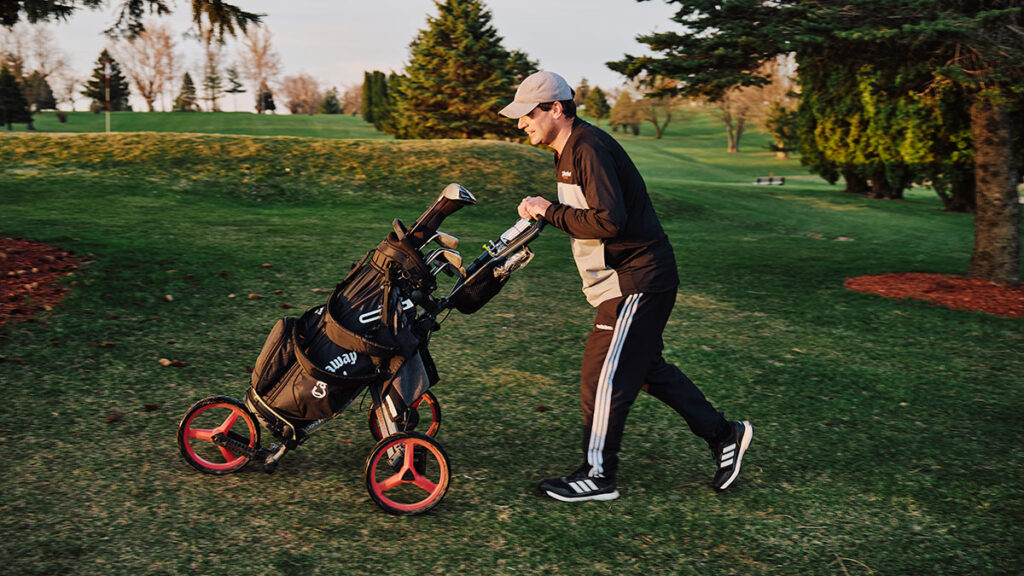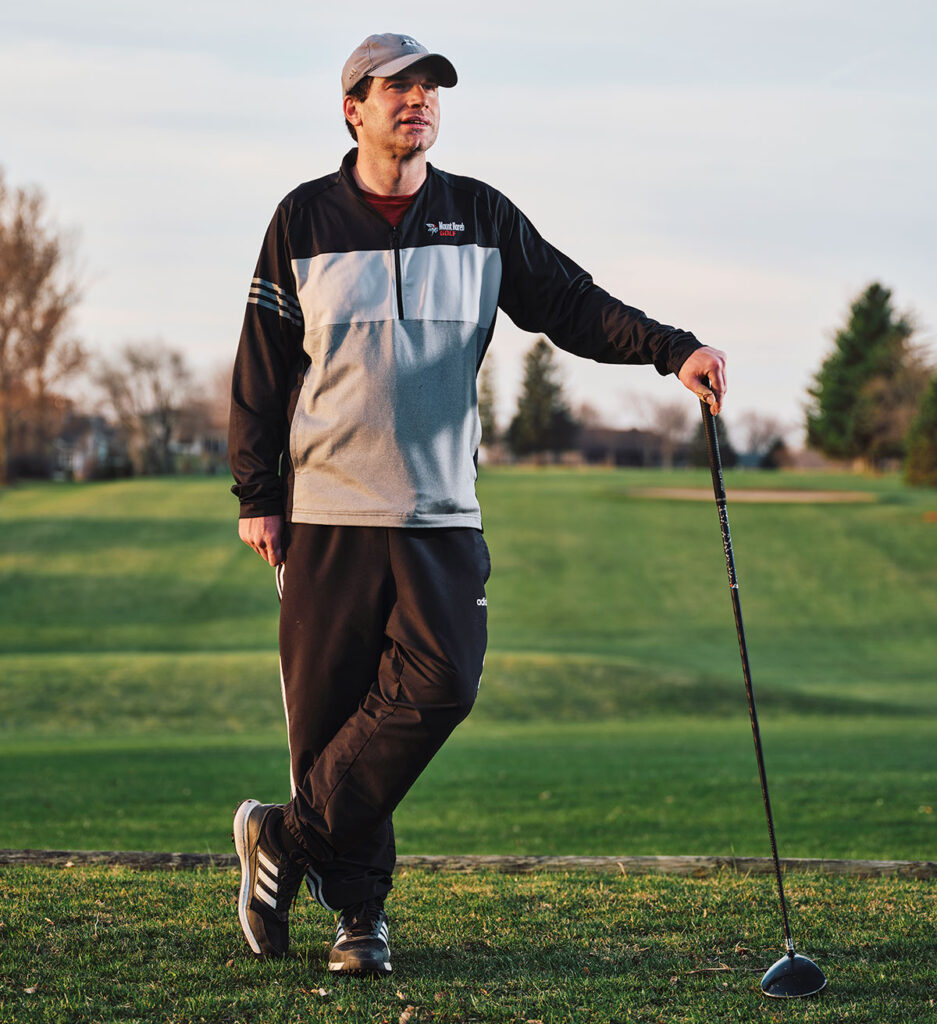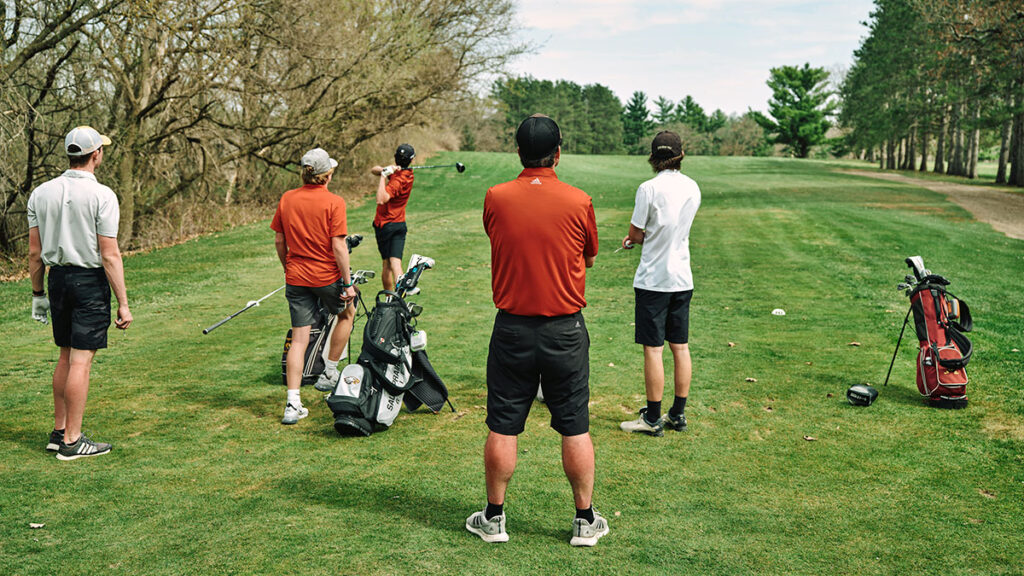Nolan Krentz played more thank 18,000 holes last year. Nearly all were on his local nine-hole course. It wasn’t enough. We can’t figure out what makes him so… driven.
He tees up the ball in darkness. Other than people and even cars on the surrounding road, Nolan Krentz likes the feeling of being alone, as if the entire nine-hole course is his while the world sleeps. It will be at least an hour before he sees anyone except for the course superintendent, who likewise knows the only other shadowy figure must be Krentz.
No practice swing, no waggle, no waste. Krentz, 32, walks fast in the dark over ground he has known since childhood, where last year he clocked the majority of his 18,018 holes.
He takes only 45 minutes to play nine, and when he finishes that loop, Mike Woodward, Norsk Golf Club’s general manager, is just pulling in. “He is usually here before I arrive, and I get here at 6,” Woodward says. “He tees off in the dark, and if he can’t find his ball, he will walk all the way back to the tee and hit it again.”

“That’s true,” Krentz says, but adds, “I try to hit a low one so that I can keep my eye on it.”
Where some see a compulsion or obsession, Krentz sees part of an everyday routine, no different than a runner who rises each day to meet the pavement. His days are often busy. He works at the local Hy-Vee grocery store and coaches boys and girls golf for Mount Horeb High School, his alma mater, and boys basketball at Iowa-Grant, 45 minutes from his home. Even with those responsibilities, Krentz’s life is built around playing golf: seventy-two holes a day is normal for him in summer; 36 is a disappointment.
If he didn’t commit so much time to golf, what would become of him? “I’d probably be a better basketball coach,” he jokes. Krentz can’t tell you why he does it, what compels him to push his body up and down Norsk Golf Club again and again, round after round. He pulls his clubs from the back of his van where they are basically permanently affixed to his pushcart. This is not a fussy set. The irons are 15 years old, purchased when he was still in high school, and his white putter insert has a wear pattern the colour of mustard and might be dented. His generic 3-wood headcover is dry-rotted and flaking. His R9 driver is losing paint like a vintage automobile and was re-shafted after the original snapped. Asked if he got fitted for the new shaft, Krentz laughs. “No, I just put another one on there. Seems to work fine.” He knows new clubs would help him gain distance and maybe accuracy, but he doesn’t have time to fool with it. Playing is the important thing.
The pushcart is the newest thing he owns – just six months old – but already failing after 500 nine-hole rounds. The handle won’t stay upright, and it’s still covered in shrink-wrap as are his golf bag’s legs.
“Did you think about removing the plastic?” I ask.
“Naw. It’ll just fall off,” he says.
Krentz steps to the first tee and pulls the club back up high, his right elbow flared a little, then he snaps it down into the slot and hits a tight draw down the first fairway. The course, wet and brown from a long midwestern winter, is soft. Krentz plays for bounces he expects on dry summer days and keeps coming up short. His ball collects mud, and his 6-iron is about as clean as a garden trowel. On one green, I ask if he would like to wipe off his ball.
“No,” he says, with a small laugh.
“Are you sure? It’s pretty dirty.”
“Honestly, it’d just slow me down.”
Speed is Krentz’s game. There’s a number in his head he wants to hit each day, which varies. That number for all of 2022 was 18,018 holes, which was roughly 500 more than in 2021 and two thousand more than in 2020. Krentz says he wanted to see if he could keep beating his number. Like all golfers he is an amateur meteorologist, checking his weather app mostly for snow in late autumn and early spring. If the app is wrong and a snow shower closes the course, he is crestfallen.
“When you put it in perspective, it’s hard to believe how much he plays,” says his brother, Geoffrey. “He’ll play unless it’s storming and lightning. He’ll play through heavy rain and high winds and in the snow unless it’s so much he can’t play.” As to why his brother pushes himself as if he’s running “a marathon every day”, Geoffrey can only guess. “It’s probably good for him emotionally and mentally to get that physical exercise. He really enjoys the quiet mornings when it’s just him on the course, the birds and the sound of the lawnmowers going.”
Krentz agrees he finds tranquility on the course, but given the number of holes he plays, how fast he gets through them, sometimes running from one hole to the next, tranquility doesn’t square with why he unforgivingly pushes himself. “I do have a drive to do it,” he says. “I remember watching runners in town train for marathons or Ironman competitions and thinking, What are those people doing? But now I get it. It’s just that drive to accomplish something of your own, a personal achievement.”

His high school golfers arrive after school with their clubs slung over their shoulders. Krentz has just finished nine holes and waits for them on the putting green. A brisk wind negates the sun, but many of the boys still wear shorts and shirtsleeves. There’s a big match in Dodgeville tomorrow, and Krentz wants them to prepare for it with today’s practice. “Take this seriously,” he tells them. “Putt everything out just like in a tournament. Every stroke counts tomorrow.” He puts them into foursomes, mixing his best players into different groups, and then he and Geoffrey watch them go off. The Krentz brothers walk from fairway to fairway, checking in but not offering much in the way of what we might think of as coaching. Swing mechanics are not discussed. No wisdom about the holes or competition is shared. Nolan says his coaching philosophy is simple. “Stay out of the way if they’re playing well and offer encouragement if they’re not.”
As the boys come in from their rounds, he makes them each perform a putting routine, and I go inside the Norsk clubhouse to have a beer with Mike Underwood, one of Krentz’s supporters and a member of the Arsenal Golf and Social Club, a booster club for the golf teams. Underwood moved back to Mount Horeb after a long career in Madison at Rayovac Batteries, where part of his duties included wrangling spokesmen Andy North, Arnold Palmer and Michael Jordan. Underwood learned to play the game at Norsk as a boy, just like Krentz. “When I came back, I looked at him as an oddity and a curiosity,” he says. “As I’ve gotten to know him, though, I’ve come to admire him. I’m fascinated by what the game gives us as golfers, and walking these loops gives him something.”
Jeff Lombardo, whose son plays for Krentz, has a house near the eighth tee and has watched Krentz over the years. “He’ll clean the snow off the ball and then sweep a path to putt.” As a source of amusement, Lombardo used to record videos of Krentz and call his kids in to watch. But the more he saw Krentz out there, the more he saw how committed Krentz was to playing. “One day I realised he’s getting something out of this,” Lombardo says. “I don’t know what it is, and I’m no psychoanalyst, but I realised he needs this. It’s doing something for him. When I understood that, I came to admire him for it.”
Not everyone is so taken with Krentz. Woodward has shared e-mails with Krentz from golfers who complain about his pace of play and the way he seems to rush groups in front of him. “I said, ‘Look, this is how some guys view you.’” It was the players who seemed to be bothered by Krentz’s endless loops that caused the Arsenal club to look for ways to get Krentz recognition for his achievement.
Rebuffed by Guinness World Records because a witness was needed for all of the holes he played (who would walk thousands of holes alongside him?), the Arsenal club turned to the Wisconsin State Golf Association, which sent representatives to Norsk in October 2022 to award Krentz a plaque that recognises “his remarkable achievement of playing 987 rounds or 17,766 holes of golf in 2021”. He eclipsed that figure at the end of 2022 partly by teeing off “when the frost was off, and I’d go for 90 holes”. Krentz stopped at 18,018 because he liked the symmetry of it. “It was an easy number to remember, and I finished the round with a birdie,” he says. “I figured it was good to call it there.”

MOUNT Horeb, Wisconsin, is 25 minutes west of Madison. Norsk is a nine-hole ‘muny’ that rises and falls with the landscape typical of Wisconsin’s Driftless region, a large landmass of undulating hills and swaying prairie grass untouched by glaciers during the last ice age. At 2,500 yards, Norsk isn’t a difficult course. Its primary defence is its small greens. Krentz regularly shoots par or better, but he really only cares about his holes for the day, of course. This year he says he is 50 percent behind where he was last year – about 450 rounds – and he doesn’t think he’ll get to 18,000 holes. “My goal, though, is to go over 150 holes in a day with 17 nine-hole rounds at Norsk,” he says, which would beat his previous personal record of 144 and 16 nine-hole loops.
Krentz says the marathon golf days started when Norsk was in danger of being closed. In 2016, the course, then privately owned, was offered for sale for $US2.15 million. The town offered to buy the course pending a referendum to approve. “I said, ‘All right, I’m going to play as many holes as I can because when the vote comes up, I don’t know if I’ll have a course.’ I thought I might not ever be able to play Norsk again.” The course’s owners wanted to sell the land to developers. Had the city not purchased the course with voter approval, 51 acres of greenspace would have been lost to retail and residential development.

Norsk is home to some of Krentz’s earliest memories. His mother, DeLayne, brought Krentz and his brother to the course for lessons when they were very young and then to play nine-hole loops when they were able. “She’d get a cart and drag us around the course,” Geoffery recalls. Neither parent played much golf, but they took the boys across southern Wisconsin to play different courses. “Ironically, it was kind of old to just play the same course over and over,” Geoffery says.
“We weren’t a sedentary family,” says DeLayne who also taught her boys that “if a community gives something to you, you have an obligation to give back.” This might explain Geoffery’s immersion into refereeing high school basketball and Nolan’s commitment to coaching. As to why her son plays so much, DeLayne says, “At this point in his life it just gives him something he needs, and as a parent, you try to support your children.”
Had Norsk closed, Krentz says he would have relocated to another course 25 minutes away, but it’s hard to imagine him playing this much anywhere else because “Norsk is home”. To hear Underwood tell it, Krentz’s dogged playing and notoriety “has done marvels for his acceptance around the club and how he’s presenting himself. He’s becoming more and more open to conversations and camaraderie.”
On the day I followed along, everyone stopped Krentz to ask how he was doing, how many holes he had played this year. They lament and commiserate with him on the weather, knowing what can trip him up and what can’t. They seem pleased by his small bit of fame. Everyone seems to know his quirks, a word Krentz embraces about himself, and what comes with it. They know, for instance, he tracks every round and every putt in a spreadsheet at home, but he doesn’t keep a handicap. They know he loves numbers because he keeps the stats for the football and volleyball teams. The stats are a way to keep himself honest and in the moment, talismans he never revisits but that are important to collect nonetheless as a record of how he has used the days. Some players he meets on the course ask how his schooling is going and know he’s on pace to finish his education certificate in the American spring as he hopes to get into teaching maths and coaching full-time.
Krentz bounces as he walks to each ball with a seemingly unlimited supply of energy and a back made of memory foam. He’s perhaps also partially evolved from a camel, as he carries no water or snacks except on days that he is going for more than 100 holes. Woodward estimates that Krentz bought only two soft drinks in the clubhouse in 2022. Woodward has also determined that each round Krentz plays works out to $0.28 per round. The fact that his most reliable customer isn’t buying anything from the bar is the source of bemusement and frustration, but he also explains it away simply: “That’s just Nolan.”
Krentz might seem like an outlier, but there are others with a similar passion and drive to see how far – and how often – they can chase a white ball. Texan Barry Gibbons, who Golf Digest profiled the year of his record, walked 878 18-hole rounds in 2016 and later walked an astonishing 1,235 rounds in 2020 or 22,230 holes. Unlike Krentz, who began his odyssey in his youth, Gibbons took up his pursuit after a career at IBM in which “he missed out on a lot of golf”, he says, and was maybe “trying to make up for it” in his retirement. When he heard of Krentz’s accomplishment, Gibbons sent Krentz an e-mail of congratulations, telling Krentz he hoped to visit him in Wisconsin to play a round. Of his reasons for endless golf, Gibbons says, “I’m the kind of person who likes to challenge myself with difficult things. That’s what makes me tick.” He eclipsed Krentz’s record year by some four thousand holes, but Gibbons isn’t in a race against anyone. “I’m not competitive about who has played more holes because I’m not competing against any of these other people,” he says. “For me, it was about challenging myself to see how far I could go, more than trying to beat anyone.”
Gibbons says he views the record for rounds and holes played in one year as his, “but I fully expect someone will beat it. When that happens, as long as it’s done legitimately, I’ll respect the accomplishment – no animosity or regrets because I did all I could possibly do.”

Krentz is committed to a version of golf that is pure to him, which means walking, hitting each shot – even the two-inch putts – and taking all his penalties. People scratch their heads and want to know why. They want to believe that anyone who pushes himself to the brink must have good reasons, but Krentz is unexplainable. “That’s just Nolan” is a way of life at Norsk. When I ask Krentz if he thinks his mother would like it if he made time for a significant other, he laughs, “Probably.” When I ask her the same thing, she also laughs. Again, she says she supports what he wants to do and where he is.
“Let’s not forget he’s a very gifted golfer,” Underwood says. “I keep asking him what’s next.” Underwood wants Krentz to play in amateur events to test himself against others, but Krentz is resistant. “I’d have to learn a new course,” he says. This doesn’t thrill him in part because he would have to drive there. “It might take an hour or two hours, and that could be three rounds I get in at Norsk instead of being in the car.”
Even when winter keeps him from playing, he will walk the course in snowshoes, following the routing of the course, making endless loops, like a bird with clipped wings. “Playing competitive golf post-high school never really interested me, but as a person you’re always trying to be different, and from a golf perspective, playing tens of thousands of holes has done that for me.” Sometimes, it feels as if Krentz is golf adjacent because so many of the things that drive us to the game are non-factors to him, and then he tells me one of his best moments on the course was when he shot 30. Like every other golfer the allure of going low seems to pull at him too just when I think it doesn’t.
On my last night in Mount Horeb, Krentz and I played 12 holes together, finishing with a truncated three-hole loop. When I teased him that I finally outdrove him, he only shook his head, acknowledging its truth, neither pleased nor displeased. He is a quiet player, complimentary when needed but focused mostly on his game. He says he enjoys playing with others, and I never got the sense I was holding him up. In fact, although he often plays alone, enjoying a round with other people if they can play fast delights him. “It’s fun to play with others, whether it was like those three holes we played together or if I’m playing with a twosome or threesome moving right along,” he says. “That’s almost as fun as playing by yourself.”
I ask him what he thinks of the Arsenal guys reaching out on his behalf as a way to quiet his critics. “I honestly didn’t know that was the reason, but I’m forever grateful to them,” Krentz says. “I appreciate more what they do for the [high school] program. It’s not about me.”
Krentz says he views every round he plays “as an opportunity to do something I’ve never done before on a golf course”, but like most of his answers, he does not offer specifics. There is a picture in his head he can’t reveal to me. “I hope I’m not too much of an enigma,” he says. Though the rounds have sapped him of nearly all his free time, he says he doesn’t feel as if he has cut himself off from the world. “I’d say it’s the opposite. I feel like golf has let me meet and develop so many different relationships.”
As twilight approaches, a dimming sun streams honeyed light onto the course. We say our goodbyes, and off he goes to the first tee, alone. He strikes a fourth or fifth opening drive of the day down the middle and walks after it.
Photos by Matt Nagar




